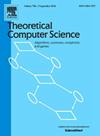遗忘型移动机器人在无限网格中的停车问题
IF 0.9
4区 计算机科学
Q3 COMPUTER SCIENCE, THEORY & METHODS
引用次数: 0
摘要
本文研究了移动机器人群的停车问题。机器人被部署在一个无限网格的节点上,该网格有一个被标记为停车节点的前置节点子集。停车节点 pi 的容量为 ki,这是一个输入值,代表它能容纳的机器人数量。作为停车问题的解决方案,在最终配置中,机器人需要将自己分成若干组,以便每个停车节点包含的机器人数量与该节点的容量相等。假设初始配置中的机器人数量等于停车节点的容量总和。假设机器人是自主的、匿名的、同质的、相同的和遗忘的。它们在异步调度程序下运行。它们在坐标轴上没有任何共识,也没有共同的手性。所有无法解决问题的初始配置都已确定。针对其余配置提出了一种确定性分布式算法,确保了问题的可解决性。本文章由计算机程序翻译,如有差异,请以英文原文为准。
Parking problem by oblivious mobile robots in infinite grids
In this paper, the parking problem of a swarm of mobile robots has been studied. The robots are deployed at the nodes of an infinite grid, which has a subset of prefixed nodes marked as parking nodes. A parking node has a capacity of , which is given as an input and represents the number of robots it is capable of accommodating. As a solution to the parking problem, in the final configuration, robots need to partition themselves into groups so that each parking node contains a number of robots that are equal to the capacity of the node. It is assumed that the number of robots in the initial configuration equals the sum of the capacities of the parking nodes. The robots are assumed to be autonomous, anonymous, homogeneous, identical and oblivious. They operate under an asynchronous scheduler. They do not have any agreement on the coordinate axes, nor do they agree on a common chirality. All the initial configurations for which the problem is unsolvable have been identified. A deterministic distributed algorithm has been proposed for the remaining configurations, ensuring the solvability of the problem.
求助全文
通过发布文献求助,成功后即可免费获取论文全文。
去求助
来源期刊

Theoretical Computer Science
工程技术-计算机:理论方法
CiteScore
2.60
自引率
18.20%
发文量
471
审稿时长
12.6 months
期刊介绍:
Theoretical Computer Science is mathematical and abstract in spirit, but it derives its motivation from practical and everyday computation. Its aim is to understand the nature of computation and, as a consequence of this understanding, provide more efficient methodologies. All papers introducing or studying mathematical, logic and formal concepts and methods are welcome, provided that their motivation is clearly drawn from the field of computing.
 求助内容:
求助内容: 应助结果提醒方式:
应助结果提醒方式:


